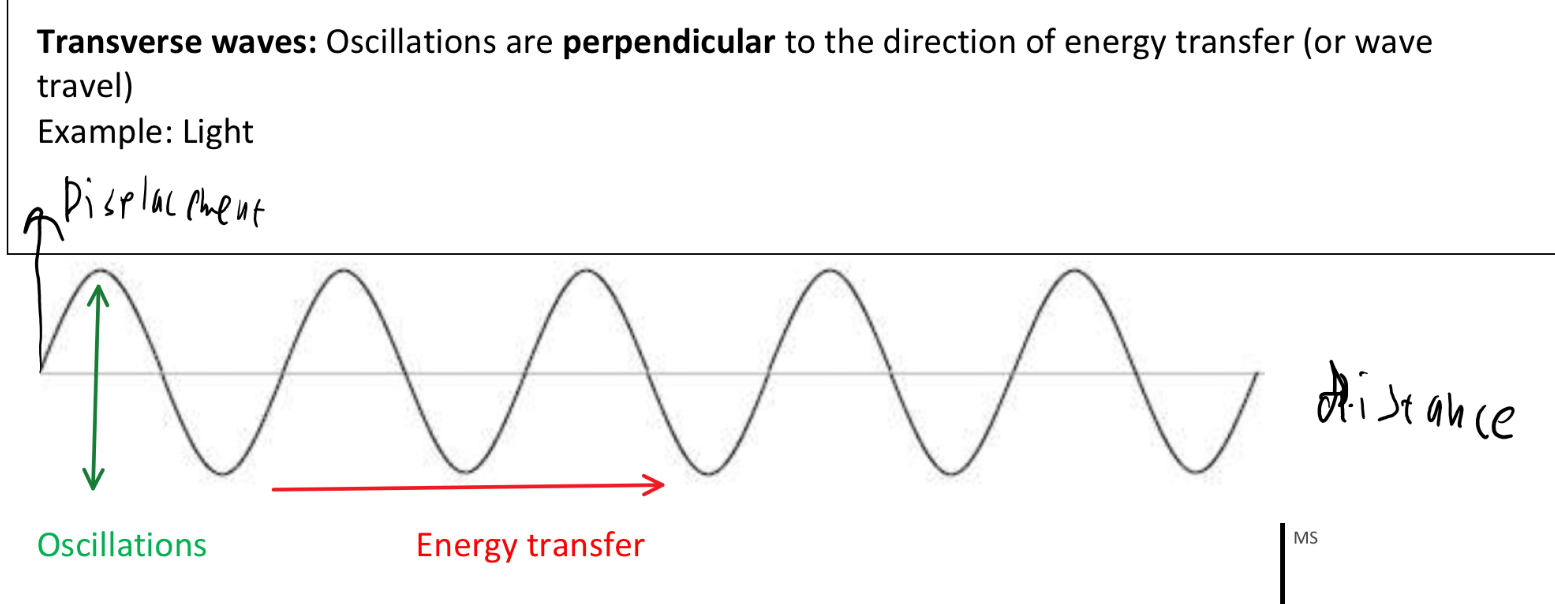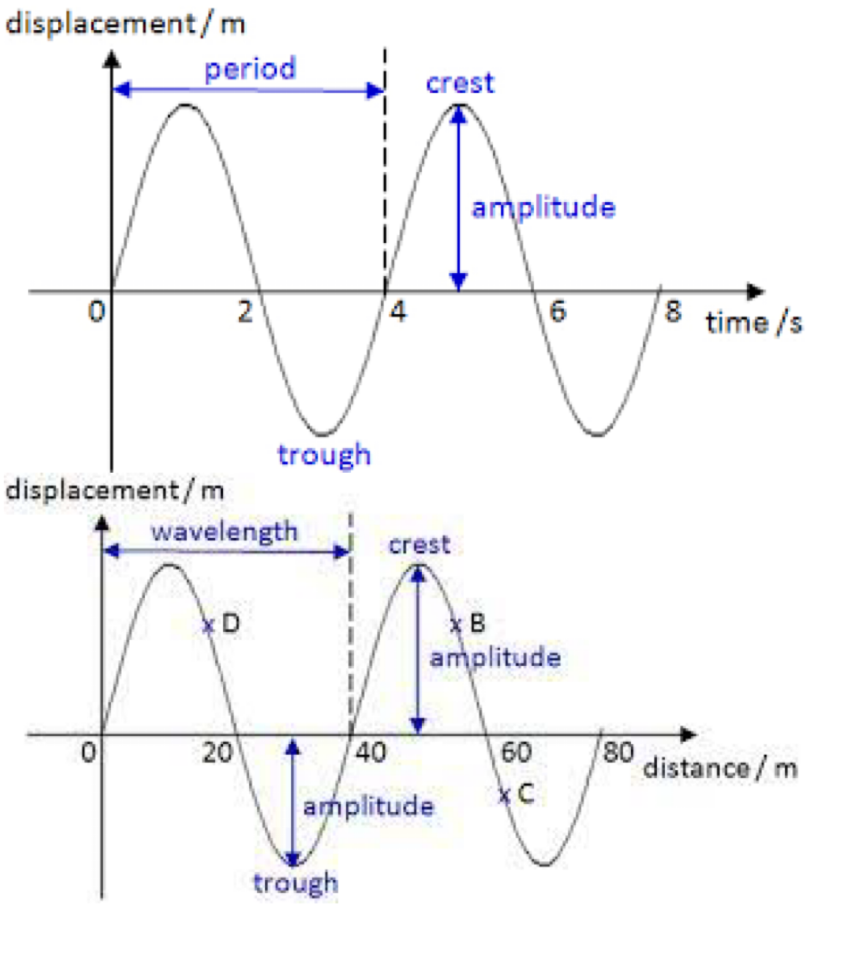Waves
Types of waves
Transverse and Longitudinal
Sound
Light
Radio waves
Water waves
Earthquakes
Tsunami
What is a wave and what does it do?
Through oscillations transfers energy
The matter does not move—no transfer of materials just energy
Some waves require mediums—sound and water
Picture of transverse wave

Transverse waves
Wavelength: The distance between a particular point on a wave and the same point on the next wave (i.e. from one peak to the next peak)
Amplitude: The maximum displacement of particles from their equilibrium (resting) point
Time period: Time taken for one complete oscillation, measure in seconds
Frequency: Number of complete oscillation per second, measure in Hz OR s-1
Displacement: The height change from the bottom to the top
Crest: highest point
Trough: lowest point
Types and uses and dangers
Radio waves-TV signal-NONE
Microwaves- heating food-Internal Heating
Infra-Red- Night googles- Burns at high intensity
Visible light- photography- NONE
Ultra-Violet- Tanning beds- Skin Cancer
X-Rays- Seeing bones- Cancer
Gammas rays- sterilising- Cancer
Time vs Distance graphs

Frequency and wave speed equations
v=f x λ
A - Amplitude - maximum displacement from equilibrium position
λ - Wavelength [m] The distance between a particular point and the same point on the next wave
T - Time period [s]- Time for one complete oscillation
f - Frequency [Hz OR s-1] - Number of full oscillations per second
v - wave speed [m/s]
Example 1 : Speed of sound is 330m/s. Human hearing range is
20Hz-20 000Hz. Find the wavelength of 20Hz and 20 000Hz sound wave.
a)
v=f x λ
330=20Hz x λ
330/20=λ
λ=16.5m
b)
v=f x λ
330=20 000Hz x λ
330/20 000=λ
λ=0.0165m = 1.65cm
Sound waves
Longitudinal wave.
Created by vibrations. Sounds needs a medium to travel through (does not travel through vacuum). Speed of sound in air 330m/s
Sound travels fastest in solids, slowest in gases, because particles are closest in solids. (Better science: Stronger bonds in solids allowing particle vibrations to be transferred more effectively).
We cannot hear through wall very well, because sound changes mediums and most of it is reflected, even though sound travels well in solids.
Frequency of sound is pitch, human hearing range 20Hz-20 000Hz, ultrasound is sound above human hearing range 20 000Hz+. Amplitude of sound is related to loudness (measure in decibel)
Speed of sound experiment:
Oscilloscope
Speaker, 2 microphones (same distance away from speaker) connected to oscilloscope (Cathode Ray Oscilloscope). CRO shows the 2 sound waves, we move the microphones until the waves align. When this happens the distance between microphones is 1 wavelength, we multiply by the frequency of sound displayed on signal generator and we get speed.
Types of Waves
Overview
Waves are disturbances that travel through space and matter, transferring energy from one point to another without permanently displacing the medium.
They can be categorized into two primary types:
Transverse Waves: The oscillation is perpendicular to the direction of wave travel.
Longitudinal Waves: The oscillation occurs in the same direction as the wave travel.
Examples of Waves
Sound Waves: Longitudinal waves that require a medium (solid, liquid, or gas) for transmission. The speed of sound is approximately 330 m/s in air.
Light Waves: Transverse waves that do not require a medium and can travel through a vacuum. The speed of light in a vacuum is about 299,792 kilometers per second.
Radio Waves: A type of electromagnetic wave used for communication. They travel at the speed of light and can penetrate various materials.
Water Waves: Typically transverse on the surface, displaying characteristics of both transverse and longitudinal waves.
Seismic Waves: Produced by earthquakes; include P-waves (primary waves/longitudinal) and S-waves (secondary waves/transverse).
Tsunami: A series of ocean waves caused by large undersea disturbances such as earthquakes, characterized by long wavelengths and speeds that can exceed 500 mph in deep water.
What is a Wave?
A wave is defined by its oscillations which facilitate the transfer of energy from one location to another without the transfer of matter. Some waves require mediums, such as sound waves needing air or water to propagate, while electromagnetic waves (like light) can travel through a vacuum.
Characteristics of Transverse Waves
Wavelength (λ): The distance between identical points on consecutive waves (e.g., from peak to peak).
Amplitude (A): The maximum displacement of the wave from its equilibrium position, representing the energy carried by the wave.
Time Period (T): The time taken for one complete oscillation, measured in seconds.
Frequency (f): The number of complete oscillations per second, measured in Hertz (Hz).
Displacement: The vertical distance from the equilibrium position to the crest (highest point) or trough (lowest point).
Types and Uses of Waves
Radio Waves: Used for TV and radio communication. Generally considered safe with no adverse health effects at normal exposure levels.
Microwaves: Used for heating food. Prolonged exposure can cause internal heating and burns due to interactions with body tissues.
Infrared Waves: Utilized in night vision technology. High intensity can cause burns.
Visible Light: The spectrum of light visible to the human eye, used in photography and vision. No known dangers in normal exposure levels.
Ultraviolet Waves: Found in sunlight and used in tanning beds, can lead to skin cancer with excessive exposure.
X-Rays: Employed in medical imaging to view bones; long-term exposure can increase cancer risk.
Gamma Rays: Used in sterilization processes; are highly penetrating and can pose serious health risks such as cancer.
Time vs Distance Graphs
Graphs that plot the relationship between time and distance for wave propagation can help visualize wave speed and interactions with mediums.
Frequency and Wave Speed Equations
The fundamental equation relating wave speed (v), frequency (f), and wavelength (λ) is:
v = f x λ
Where:
v = wave speed (m/s)
f = frequency (Hz)
λ = wavelength (m)
Example Calculations
Finding Wavelength:
Speed of sound is 330 m/s. If the frequency is 20 Hz:
(330 = 20 \text{Hz} \times \lambda)
(\lambda = \frac{330}{20} = 16.5 ext{m})
If the frequency is 20,000 Hz:
(330 = 20,000 \text{Hz} \times \lambda)
(\lambda = \frac{330}{20,000} = 0.0165 ext{m} = 1.65 ext{cm})
Sound Waves
Sound waves are longitudinal waves created by the oscillation of particles in a medium.
Sound cannot travel in a vacuum due to the absence of particles to transmit vibrations.
The speed of sound is fastest in solids because particles are closely packed, making it easier for vibrations to transfer.
Sound frequency determines pitch, with human hearing ranging from 20 Hz to 20,000 Hz, while ultrasound exists above this range.
The amplitude of sound waves correlates to loudness, measured in decibels (dB).
Speed of Sound Experiment
An oscilloscope can visualize sound waves. In an experiment, two microphones placed equidistant from a speaker help calculate wave speed by aligning waves and determining the wavelength through measurement and then using the provided wavelength and frequency to find the speed.